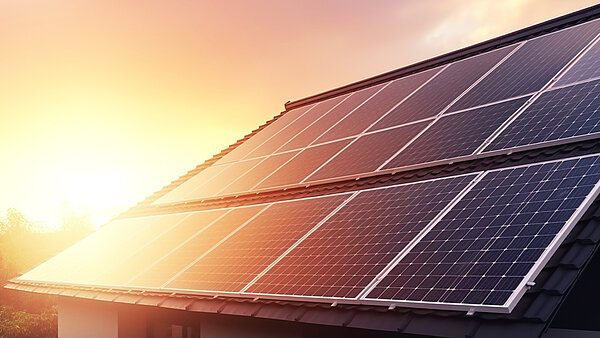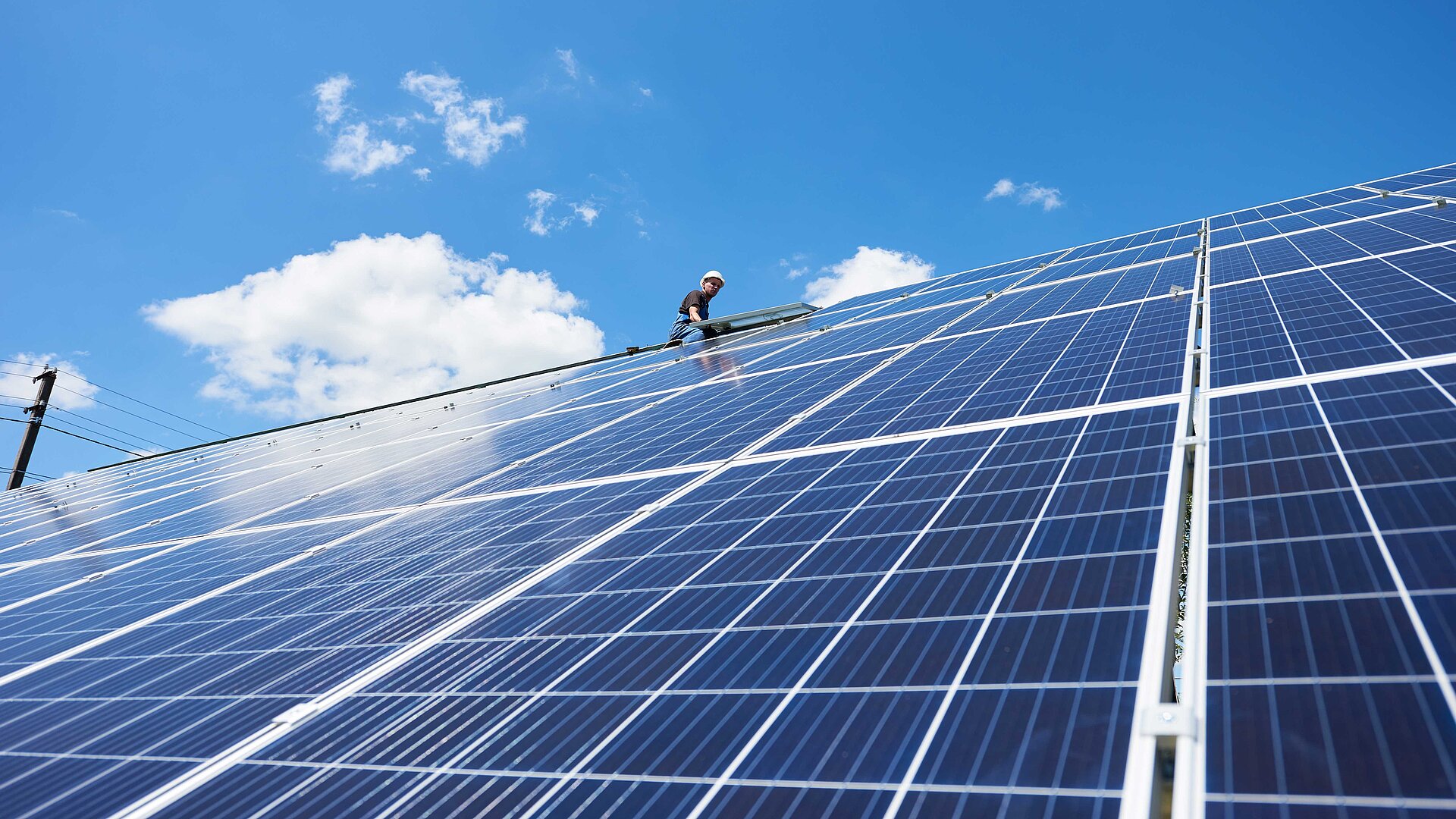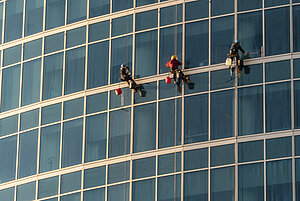While on flat roofs the main areas to be correctly secured are those close to the roof edge as well as skylights, the whole of a pitched roof is a workplace with high fall risk, because of the sometimes very steep inclination. One brief moment of inattention have serious consequences. And that’s what has to be prevented – in the interest of the employees and those responsible. In this post you will find the most current situations from practice, all of which bring their own unique challenges.
The route onto the roof and to the photovoltaic system
Ideally, permanently anchored and appropriately secured access points or permanently installed stepladders with guardrails exist for accessing the roof or PV system. However, in practice this best-case scenario unfortunately tends to be the exception. Much more often, the situation is diametrically opposed: simple ladders, or unsecured roof hatches or roof windows, have to be used for the ascent to the“PV system” workplace. Generally the installers, solar technicians, and servicing and cleaning workers also have tools or installation and cleaning materials with them, and so one hand is not free – another handicap which must not be underestimated. If the transition to the roof also has to be made from an unstable simple ladder leaning against the roof edge, then that is the absolute worst case. And for this it makes little difference whether the roof is flat or pitched.
It is hugely important that the first anchorage device is in immediate proximity to the ascent aid, such as the simple ladder, and is easily accessible for the respective worker. He/she is then able to secure himself/herself appropriately, even before transitioning to the roof. This is of decisive importance for pitched roofs above all, because of their inclination, as there are often no safe tread surfaces after the transition. Roof hatches or roof windows are also used as access points on the roof, and they thus form the transition between the safe and unsafe areas. Here too, the first anchorage devices must be positioned to be easily accessible for servicing and cleaning workers.
On the roof and at the PV system
It is completely understandable: Operators of PV systems wish to fit the maximum surface area of solar panels onto their roofs, in order to generate the maximum amount of solar energy. However, this also means that little space is left to access the PV system for cleaning and servicing tasks.
Problems of PV systems on a flat roof
For the workers to perform their tasks on a flat roof, only very narrow strips are therefore generally available, and these are directly adjacent to the fall edge and in the areas around skylights. These areas of particular danger with increased fall risk must therefore be protected by a professional, certified solution.
Problems of PV systems on a pitched roof
The problem of space becomes even more acute on a pitched roof. In addition to the danger of a vertical fall from the roof edge, in this case the inclination in itself represents a huge potential danger. It can be sufficient to lose one’s balance briefly – anyone who slips on a pitched roof is generally unable to stop themselves. This dangerous workplace too requires a professional safety concept.
In both situations – on a flat roof and on a pitched roof – the following applies: installers and solar technicians, or servicing and cleaning personnel, must be able to access all areas of the PV system without problems and, above all, in safety. In this regard, the margins of the PV system represent the greatest challenge, because they are generally located in immediate proximity to fall edges.
Installation of PV systems on existing roofs
Nowadays the PV system on the roof generally forms part of the planning for new builds. However, for any building built several decades ago or earlier (and this is the usual case) where the wish is one’s own solar power plant on the roof, a retrofit will have to be performed. But this means that installers and solar technicians come up against potential obstacles such as chimneys, skylights, and smoke extraction or air-conditioning systems whose locations are fixed. This requires enormous flexibility when it comes to adapting the PV system to the existing roof geometry. And to achieve the optimum result, the safety solutions must also be capable of being adapted. In this regard, INNOTECH provides a versatile range of fall protection systems. This runs from high-quality rail systems to the most up-to-date lifeline systems, guardrail systems, anchorage devices and personal protective equipment, to a combination of all solutions with each other.
The systems are tested and certified beyond the requirements of the standard, including combination with the substructure of the PV system. In contrast, our competitors sometimes provide only single solution approaches, for example just a lifeline system or a solution using a single anchor point. For installers and customers, this means that they are unable to rely on a wide range of solutions. Depending on the situation, a comprehensive safety solution for PV systems can frequently consist of a combination of individual solutions, e.g. additional single anchor points together with a rail or lifeline system. Here it is important to ensure that all these systems or components create a safe integral system. All the systems which we provide are tested and certified in combination with each other and with the PV system – in other words, 100% safe! The retrofitting of solar power plants on a roof, or the protection of solar panels separate from the main system can be implemented optimally in this way.
Meaning of certification
Practice has demonstrated that merely certifying the fall protection system on its own is usually insufficient, especially when it is permanently attached to the substructure of the PV system, and for many INNOTECH models this is often the case, for the reasons of space and safety described above. Only when the substructure of the solar power system is tested IN COMBINATION with the fall protection system can it be ensured that in an emergency the loads generated can also be absorbed, and that working on the roof is really safe. Some fall protection systems on the market for PV systems promise safety which they are unable to deliver in an emergency. This is because they were not in fact thoroughly tested, i.e. in combination with the PV substructure.
In that case, the installer or solar technician has to test whether the substructure for the fall protection system has sufficient strength to dissipate the forces in the event of a fall. For most customers this represents a problem which is virtually insoluble. One thing is certain: However good a fall protection system is, it cannot fulfil its purpose unless the substructure to which it is attached can withstand the load. All the safety solutions which we provide fulfil all regulations and standards. In addition, installers and solar technicians benefit from the INNO|doc tool, with which they can digitally perform the mandatory documentation of the installation of the fall protection system. In addition we also undertake directly the training of installers and solar technicians, in order to ensure the correct and professional installation of the respective safety solution.
Illusion of safety
If just one of the points above has been implemented incorrectly or not at all, specialists call this the illusion of safety. In this case, the fall protection system installed causes customers, installers and solar technicians, or servicing and cleaning workers to feel that they are on safe ground, but in an emergency they may in fact be given a very tough lesson to the contrary. This is because it takes a fall to show whether the structure is able to withstand the load. That is dicing with death on the roof. And that is extremely problematic in many ways. Falls generally entail serious injuries which result in extended time off work for the employees involved. If an investigation of the circumstances which led to the fall indicates that those responsible were negligent, then this can naturally also have legal consequences.
Summary: Solution approaches fall protection photovoltaic systems
There are numerous different roof forms onto which PV systems have been installed, and these have to be serviced and cleaned regularly. However, there is a basic difference between flat and pitched roofs. On both roof types, PV systems may require very specific safety concepts, in order to mitigate the potential danger of the workplace and to protect employees. But in addition, obstacles on the roof always create challenges in terms of safety, although it is generally simple to master them by using a professional fall protection system. The important thing here is that the PV system and the safety system are tested and certified in combination. Otherwise a condition arises which nobody desires: The illusion of safety!
Contact us immediately for further information! We will be very happy to support you in selecting the right fall protection for your PV system – regardless whether it’s installed on a flat or a pitched roof. You want to make your PV system safe and efficient? Then don't miss our 5 facts about professional fall protection!








![[Translate to Englisch:] [Translate to Englisch:]](https://www.innotech-safety.com/fileadmin/_processed_/1/a/csm_Mehrere_PV-Kunden_gleichzeitig_betreuen__kann_oft_zur_Riesenherausforderung_werden-header_c1a520d846.jpg)






















